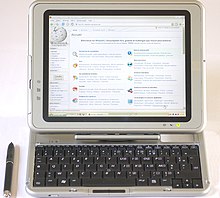 TC1100 tablet - next model with same design, with HP logo instead of Compaq logo. | |
| Developer | Compaq |
|---|---|
| Type | Laplet |
| Release date | 2003 |
| Operating system | Windows XP Tablet PC Edition |
| CPU | Transmeta Crusoe 5800 1.0 GHz, 512 KB Cache |
| Memory | 256 MB (SDRAM) |
| Storage | 30, 40, or 60 GB Hard Drive |
| Display | 10.4 Inches 1024x768 |
| Graphics | Nvidia GeForce2Go (16 MB, SDRAM) |
| Power | 40 Wh Li ion |
| Dimensions | 10.8 in × 8.5 in × .8 in (274 mm × 216 mm × 20 mm) |
| Weight | 3.1 lb (1.4 kg) 4 lb (1.8 kg) With Keyboard |
| Successor | HP Compaq TC1100 |
The TC1000 is a 10.4" laplet designed by Compaq, before it was purchased by HP. It used the Transmeta Crusoe processor. Unlike many other tablet PCs of its time (which can only operate either in a traditional laptop configuration, or with the keyboard folded behind the screen), the display is fully detachable from the keyboard. The product was developed and manufactured using ODM model from LG Electronics, Inc. of South Korea.
Contents
The TC1000 was replaced by the HP Compaq TC1100 which features a faster Pentium M processor and an integrated digitizer from Wacom (the TC1000 used a Finepoint digitizer which required a AAAA battery and lacked pressure-input, being binary on/off only), among other small upgrades.
The TC1000 comes with Windows XP Tablet PC Edition [1] but it is capable of running Linux. [2]
A restore CD is available on the Internet Archive to restore the machine to its factory configuration.

